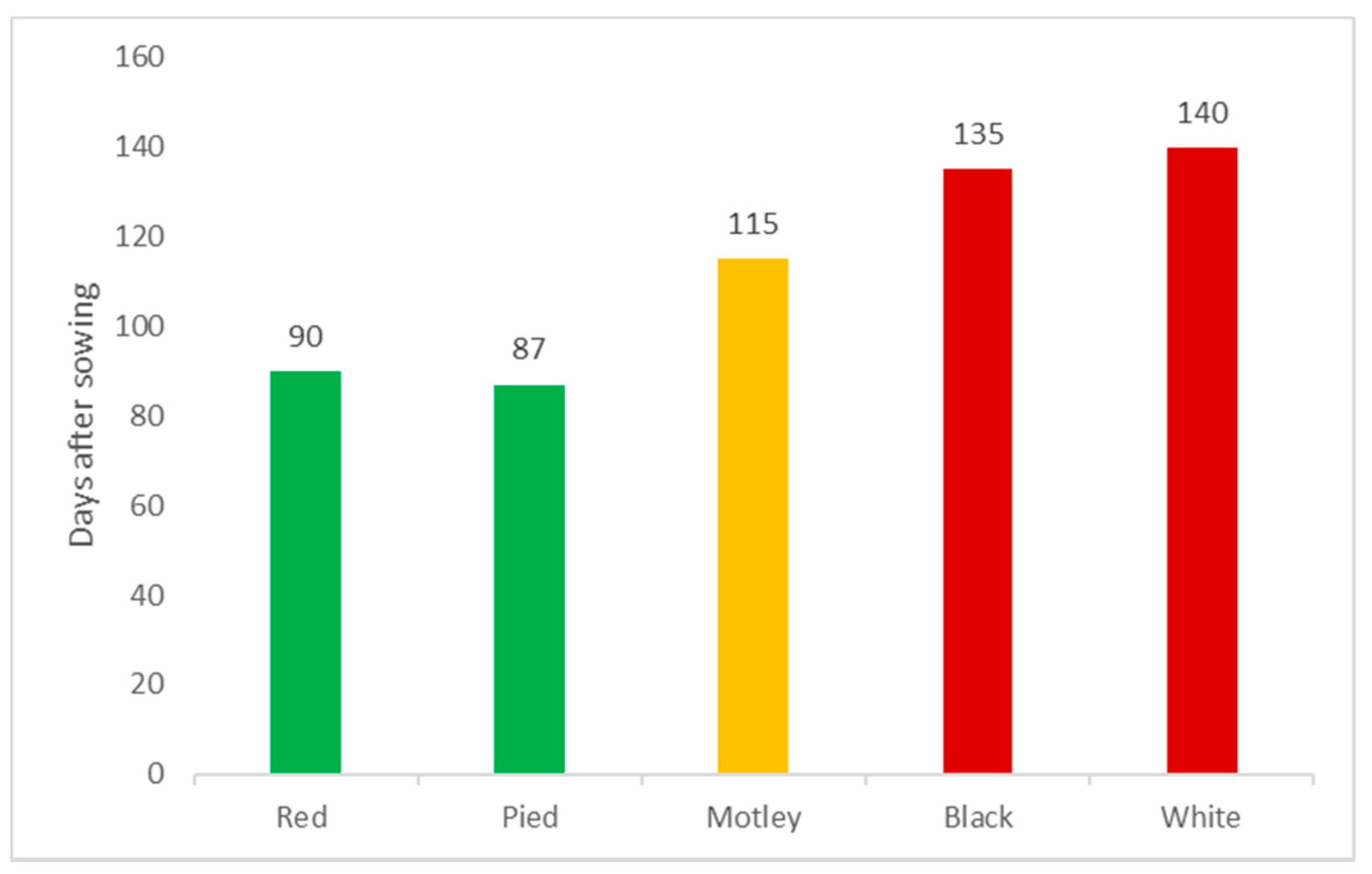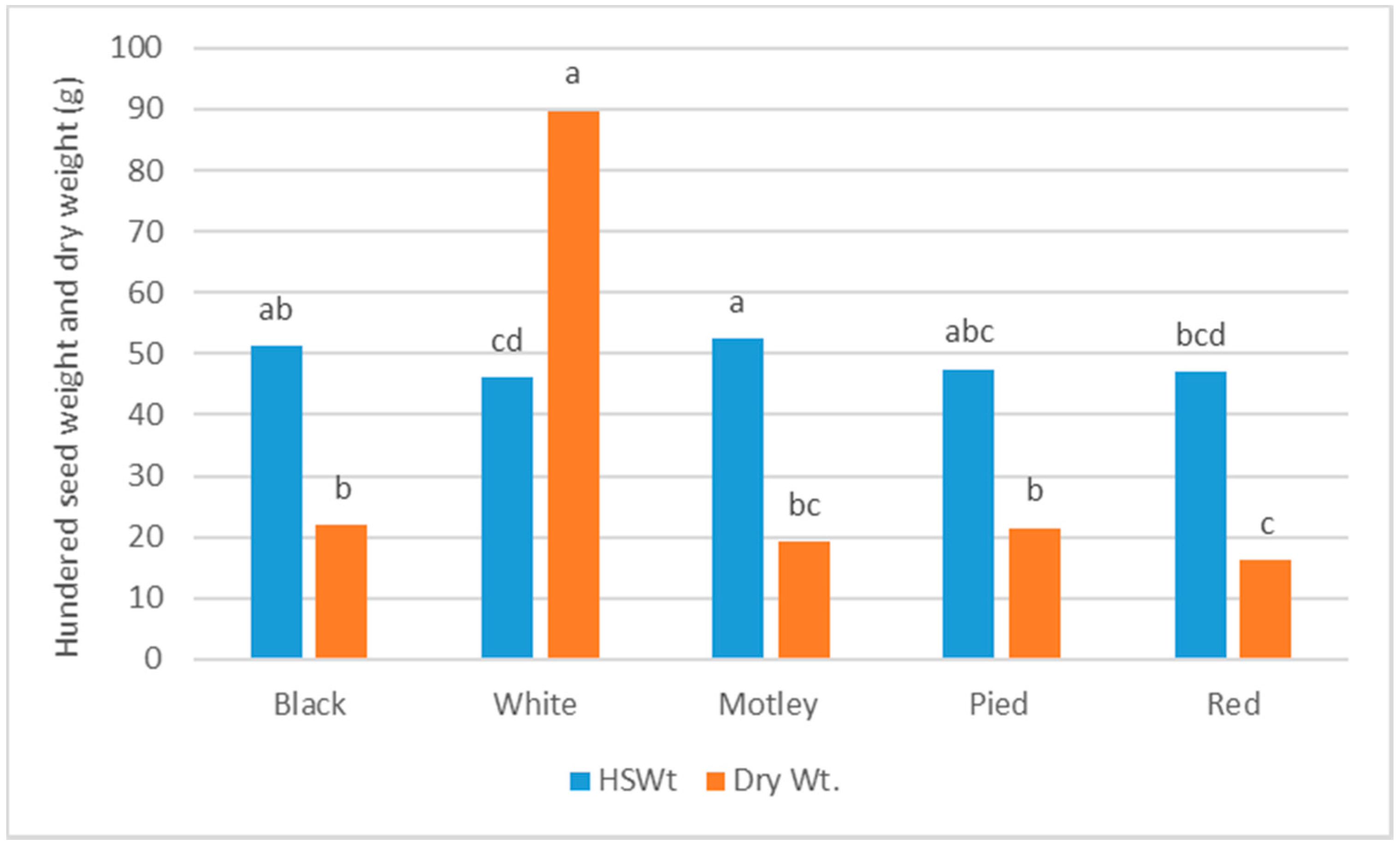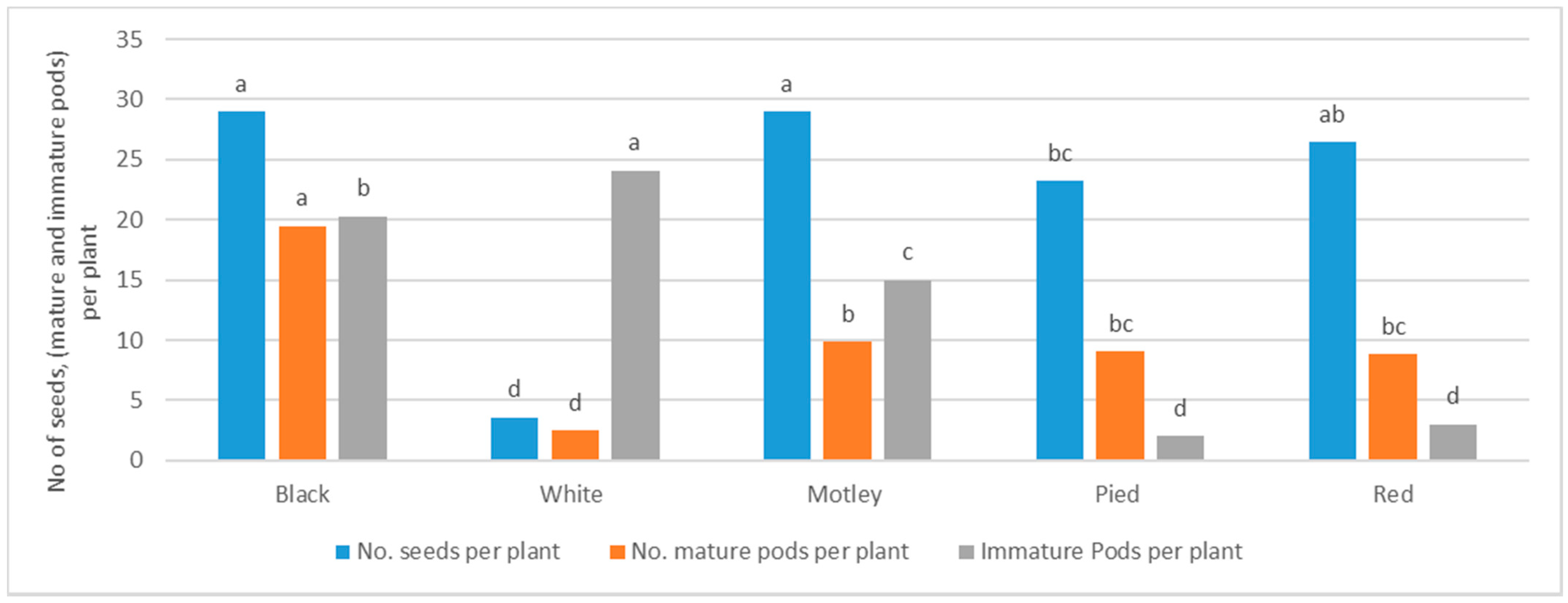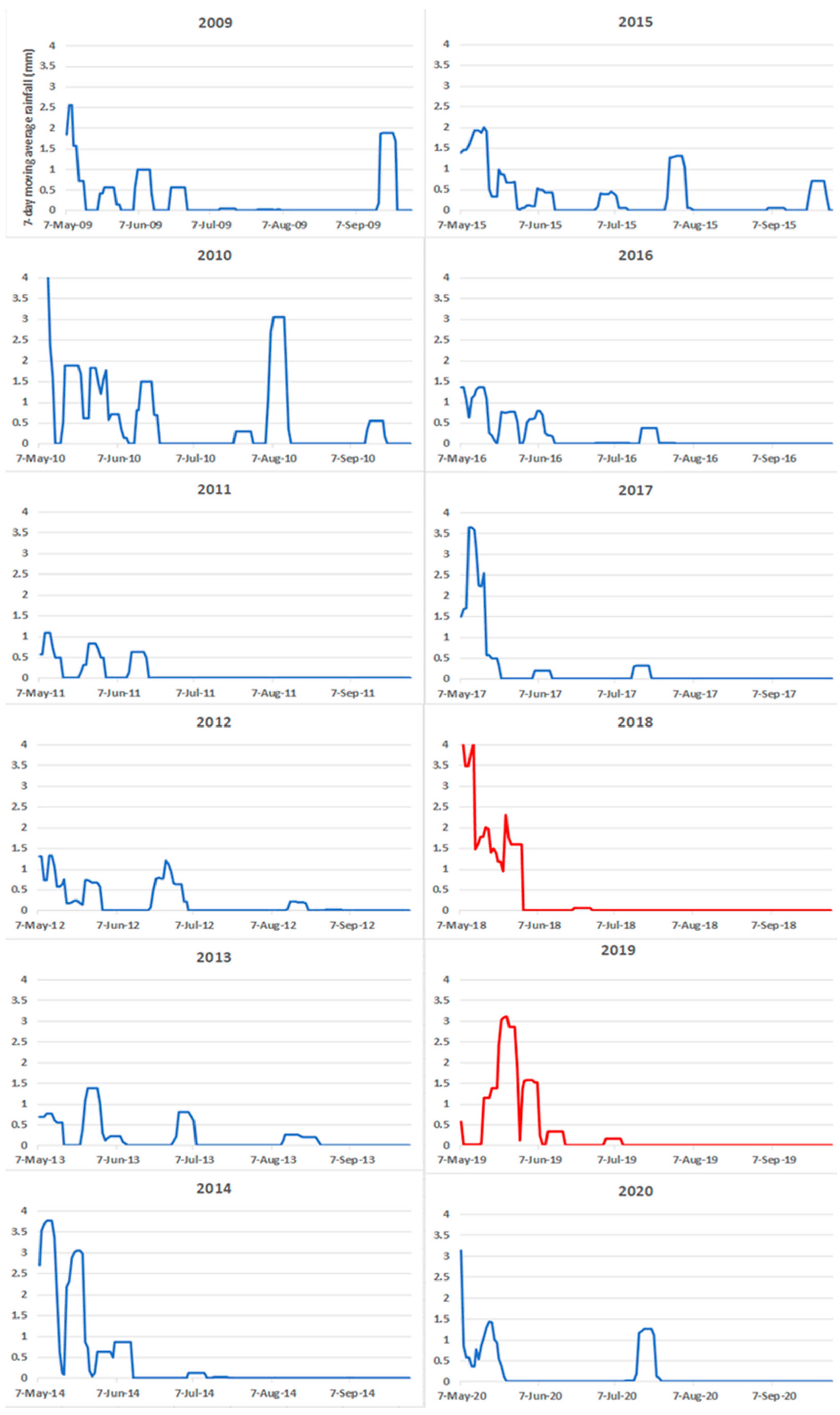Drought Tolerant Varieties of Common Beans (Phaseolus vulgaris) in Central Afghanistan
Abstract
:1. Introduction
2. Materials and Methods
3. Results
4. Discussion
5. Conclusions and Recommendations
Author Contributions
Funding
Institutional Review Board Statement
Informed Consent Statement
Data Availability Statement
Acknowledgments
Conflicts of Interest
References
- Pandey, R.K.; Herrera, W.A.T.; Pendleton, J.W. Drought response of grain legumes under irrigation gradient: 1. Yield and yield components. Agron. J. 1984, 76, 549–553. [Google Scholar] [CrossRef]
- Nadeen, M.; Li, J.; Yahya, M.; Sher, A.; Ma, C.; Wang, X.; Qiu, L. Research progress and perspective on drought stress in legumes: A review. Intl. J. Mol. Sci. 2019, 20, 2541. [Google Scholar] [CrossRef] [Green Version]
- Farooq, M.; Gogoi, N.; Barthakur, S.; Baroowa, B.; Bharadwaj, N.; Alghamdi, S.S.; Siddique, K.H.M. Drought stress in grain legumes during reproduction and grain filling. J. Agron. Crop Sci. 2017, 203, 81–102. [Google Scholar] [CrossRef]
- Beebe, S.E.; Rao, I.M.; Blair, M.W.; Acosta-Gallegos, J.A. Phenotyping common beans for adaptation to drought. Front. Physiol. 2013, 4, 35. [Google Scholar] [CrossRef] [Green Version]
- Heinemann, A.B.; Ramirez-Villegas, J.; Stone, L.F.; Didonet, A.D. Climate change determined drought stress profiles in rainfed common bean production systems in Brazil. Agric. Forest Meteor. 2017, 246, 64–77. [Google Scholar] [CrossRef]
- Hummel, M.; Hallahan, B.F.; Brychkova, G.; Ramirez-Villegas, J.; Guwela, V.; Chataika, B.; Curley, E.; McKeown, P.C.; Morrison, L.; Talsma, E.F.; et al. Reduction in nutritional quality and growing area suitability of common bean under climate change induced drought stress in Africa. Sci. Rep. 2018, 8, 16187. [Google Scholar] [CrossRef] [PubMed]
- Armah, F.A.; Odoi, J.O.; Yengoh, G.T.; Obiri, S.; Yawson, D.O.; Afrifa, E.K.A. Food security and climate change in drought-sensitive savanna zones of Ghana. Mitig. Adapt. Strateg. Glob. Chang. 2011, 16, 291–306. [Google Scholar] [CrossRef]
- Li, Y.; Ye, W.; Wang, M.; Yan, X. Climate change and drought: A risk assessment of crop-yield impacts. Clim. Res. 2009, 39, 31–46. [Google Scholar] [CrossRef]
- Lobell, D.B.; Gourdji, S.M. The influence of climate change on global crop productivity. Plant. Physiol. 2012, 160, 1686–1697. [Google Scholar] [CrossRef] [PubMed] [Green Version]
- Ray, R.L.; Fares, A.; Risch, E. Effects of drought on crop production and cropping areas in Texas. Agric. Environ. Lett. 2018, 3, 170037. [Google Scholar] [CrossRef] [Green Version]
- Broughton, W.J.; Hernandez, G.; Blair, M.; Beebe, S.; Gepts, P.; Vanderleyden, J. Beans (Phaseolus spp.)—model food legumes. Plant. Soil 2003, 252, 55–128. [Google Scholar] [CrossRef] [Green Version]
- Celmeli, T.C.; Sari, H.; Canci, H.; Sari, D.; Adak, A.; Eker, T.; Toker, C. The nutritional content of common bean (Phaseolus vulgaris L.) landraces in comparison to modern varieties. Agronomy 2018, 8, 166. [Google Scholar] [CrossRef] [Green Version]
- Porch, T.G.; Bernsten, R.; Rosas, J.C.; Jahn, M. Climate change and the potential economic benefits of heat tolerant bean varieties for farmers in Atlantida, Honduras. J. Agric. Univ. P. R. 2008, 91, 133–148. [Google Scholar]
- Fairbairn, J.N. Evaluation of soils, climate and land use information at three scales: The case of low income bean farming in Latin America. Ph.D. Thesis, University of Reading, Reading, UK, 1993. [Google Scholar]
- Wortmann, C.S. An adaptation breeding strategy for water deficit in bean developed with the application of the DSSAT3 drybean model. Afr. Crop. Sci. 1998, 6, 215–225. [Google Scholar] [CrossRef]
- Assefa, T.; Wu, J.; Beebe, S.E.; Rao, I.M.; Marcomin, D.; Claude, R.J. Improving adaptation to drought stress in small red common bean: Phenotypic differences and predicted genotypic effects on grain yield, yield components and harvest index. Euphytica 2015, 203, 477–489. [Google Scholar] [CrossRef]
- Terán, H.; Singh, S.P. Comparison of sources and lines selected for drought resistance in common bean. Crop. Sci. 2002, 42, 64–70. [Google Scholar] [CrossRef] [PubMed]
- Campos, K.; Schwember, A.R.; Machado, D.; Ozores-Hampton, M.; Gil, P.M. Physiological and yield responses of green-shelled beans (Phaseolus vulgaris L.) grown under restricted irrigation. Agronomy 2021, 11, 562. [Google Scholar] [CrossRef]
- Ramirex-Vallejo, P.; Kelly, J.D. Traits related to drought resistance in common bean. Euphytica 1998, 99, 127–136. [Google Scholar] [CrossRef]
- White, J.W.; Singh, S.P. Breeding for adaptation to drought. In Common Beans, Research for Crop Improvement; van Schoonhoven, A., Voysest, O., CAB International, Eds.; CAB International, CIAT: Palmira, Colombia, 1991; pp. 501–560. [Google Scholar]
- Porch, T.G.; Ramirez, V.H.; Santana, D.; Harmsen, E.W. Evaluation of common bean for drought tolerance in Juana Diaz, Puerto Rico. J. Agron. Crop. Sci. 2009, 195, 328–334. [Google Scholar] [CrossRef]
- Muktadir, M.D.; Adhikari, K.N.; Merchant, A.; Belachew, K.Y.; Vandenberg, A.; Stoddard, F.L.; Khazaei, H. Physiological and biochemical basis of faba bean breeding for drought adaptation—a review. Agronomy 2020, 10, 1345. [Google Scholar] [CrossRef]
- Acosta-Díaz, E.; Acosta-Gallegos, J.A.; Trejo-López, C.; Padilla-Ramírez, J.S.; Amador- Ramírez, M.D. Adaptation traits in dry bean cultivars grown under drought stress. Agric. Téc. Mexico 2009, 35, 4216–4424. [Google Scholar]
- Osakabe, Y.; Osakabe, K.; Shinozaki, K.; Tran, L.S.P. Response of plants to water stress. Front. Plant. Sci. 2014, 5, 1–8. [Google Scholar] [CrossRef] [Green Version]
- Rousta, I.; Olafsson, H.; Moniruzzaman, M.; Zhang, H.; Liou, Y.-A.; Mushore, T.D.; Gupta, A. Impacts of drought on vegetation assessed by vegetation indices and meteorological factors in Afghanistan. Remote Sens. 2020, 12, 2433. [Google Scholar] [CrossRef]
- Levitt, E.; Kostermans, K.; Laviolette, L.; Mbuya, N. Malnutrition in Afghanistan; Scale, Scope, Causes, and Potential Response; The World Bank: Washington, DC, USA, 2010. [Google Scholar]
- Nowruzi, A. Farmer’s Perception of Drought Impact on Agricultural Productivity and Rural Livelihood in Bamyan Province, Afghanistan. Master’s Thesis, Asian Institute of Technology, Bangkok, Thailand, 2015. [Google Scholar]
- Schneider, K.A.; Rosales-Serna, R.; Ibarra-Perez, F.; Cazares-Enriquez, B.; Acosta-Gallegos, J.A.; Ramirez-Vallejo, P.; Wassimi, N.; Kelly, J.D. Improving common bean performance under drought stress. Crop. Sci. 1997, 37, 43–50. [Google Scholar] [CrossRef]
- Abebe, A.; Brick, M.A.; Kirkby, R. Comparison of selection indices to identify productive dry bean lines under diverse environ- mental conditions. Field Crop. Res. 1998, 58, 15–23. [Google Scholar] [CrossRef]
- Immap. Technical Report. IMMAP Afghanistan Data Repository. Yakawlang Station, Automatic Hydrometeorology Station River Basin North, Directorate of Sub Basin Upper River of Kunduz-Bamyan. 2020. Available online: http://asdc.immap.org/account/login/?next=/ (accessed on 4 August 2021).
- Alves Souza, S.; Higino Vieira, J.; Bispo dos Santos Farias, D.; da Silva, G.H.; Cabral Aleman, C. Impact of irrigation frequency and planting density on bean’s morpho-physiological and productive traits. Water 2020, 12, 2468. [Google Scholar] [CrossRef]
- Zafarani, M.P.; Raey, Y.; Ghassemi, G.K.; Mohammadi, S.A. Effect of Limited Irrigation on Growth and Yield of Bean Cultivars; Faculty of Agriculture, University of Tabriz: Tabriz, Iran, 2012; pp. 85–94. [Google Scholar]
- Sadeghipour, O. Effect of deficit irrigation on physiologic and agronomic traits in common bean (Phaseolus vulgaris L.) genotypes. Iran. J. Crop. Sci. 2009, 11, 25–39. (In Persian) [Google Scholar]
- Bayat, A.A.; Sepehri, A.; Ahmadvand, G.; Dorri, H.R. Effect of water deficit stress on yield and yield components of pinto bean (Phaseolus vulgaris L.) genotypes. Iran. J. Crop. Sci. 2010, 12, 42–54. (In Persian) [Google Scholar]
- Fram, M.A.; Rosas, J.C.; Mayek-Perez, N.; Lopez-Salinas, E.; Acosta-Gallegos, J.A.; Kelly, J.D. Breeding beans for resistance to terminal drought in the lowland tropics. Euphytica 2004, 136, 223–232. [Google Scholar] [CrossRef]
- Beebe, S.E.; Rao, I.M.; Cajiao, C.; Grajales, M. Selection for drought resistance in common bean also improves yield in phosphorus limited and favorable environments. Crop. Sci. 2008, 48, 582–592. [Google Scholar] [CrossRef]
- Ofir, M.; Gross, Y.; Bangerth, F.; Kigel, J. High temperature effects on pod and seed production as related to hormone levels and abscission of reproductive structures in common bean (Phaseolus vulgaris L.). Sci. Hortic. 1993, 55, 201–211. [Google Scholar] [CrossRef]










| Mean Square | |||||||||
|---|---|---|---|---|---|---|---|---|---|
| Sources of Variation | Df | SPP | HGWt | Yield | P Height | Pod No | Dry Wt. | Stem No | SPPd |
| Replication | 3 | 29.1 | 92.8 | 17.9 | 455.2 | 4 | 66.6 | 2.5 | 2.6 |
| Variety (Vrty) | 4 | 1862.5 ** | 352.1 ** | 388.3 ** | 35605.8 ** | 645.6 ** | 1356.7 ** | 30.7 ** | 8.9 ** |
| Error (a) | 12 | 48.5 | 48.9 | 13.6 | 183.6 | 2.8 | 29.8 | 0.9 | 2.3 |
| Irrigation (Irr) | 3 | 233.9 ** | 8.2 ns | 92.9 ** | 916.8 ** | 65.2 ** | 254.9 ** | 0.7 ns | 1 ns |
| Vrty × Irr | 12 | 46.6 ns | 98.1 ns | 24.4 ** | 248.5 ns | 12.7 ns | 55.9 ns | 0.8 ns | 2.1 ns |
| Error (b) | 45 | 49.6 | 99.0 | 10.3 | 257.5 | 10.5 | 41.5 | 0.472 | 1.7 |
| Mean Square | ||||||||
|---|---|---|---|---|---|---|---|---|
| S.O.V | DF | HGWt. | Yield | P Height | Pod Number | Seed Per Pod | Dry Wt. | Stem Number |
| Replication | 3 | 18.3 | 70.3 | 25.3 | 8.7 | 0.6 | 245.5 | 8.326 |
| Variety | 1 | 186.8 ** | 140.2 * | 0.2 ns | 0.1 ns | 1.5 ns | 519.2 ns | 0.5 ns |
| Error (a) | 3 | 6.2 | 14.5 | 0.6 | 3.8 | 0.3 | 60.8 | 0.469 |
| Irrigation | 3 | 8.4 ns | 87.1 ** | 39.4 ** | 11.6 * | 0.1 | 309.5 ** | 2.8 ns |
| Variety × Irr | 3 | 16.9 ns | 34.3 ns | 11.ns | 2.4 ns | 0.5 ** | 153.8 ns | 1.7 ns |
| Error (b) | 18 | 31.3 | 12.2 | 9.9 | 3.2 | 0.1 | 55.5 | 1.109 |
Publisher’s Note: MDPI stays neutral with regard to jurisdictional claims in published maps and institutional affiliations. |
© 2021 by the authors. Licensee MDPI, Basel, Switzerland. This article is an open access article distributed under the terms and conditions of the Creative Commons Attribution (CC BY) license (https://creativecommons.org/licenses/by/4.0/).
Share and Cite
Hussaini, S.M.B.; Sidle, R.C.; Kazimi, Z.; Khan, A.A.; Rezaei, A.Q.; Ghulami, Z.; Buda, T.; Rastagar, R.; Fatimi, A.A.; Muhmmadi, Z. Drought Tolerant Varieties of Common Beans (Phaseolus vulgaris) in Central Afghanistan. Agronomy 2021, 11, 2181. https://doi.org/10.3390/agronomy11112181
Hussaini SMB, Sidle RC, Kazimi Z, Khan AA, Rezaei AQ, Ghulami Z, Buda T, Rastagar R, Fatimi AA, Muhmmadi Z. Drought Tolerant Varieties of Common Beans (Phaseolus vulgaris) in Central Afghanistan. Agronomy. 2021; 11(11):2181. https://doi.org/10.3390/agronomy11112181
Chicago/Turabian StyleHussaini, Sayed Muhammad Baqer, Roy C. Sidle, Zaigham Kazimi, Aziz Ali Khan, Abdul Qayum Rezaei, Zahra Ghulami, Taher Buda, Rahmatullah Rastagar, Ali Aqa Fatimi, and Zahra Muhmmadi. 2021. "Drought Tolerant Varieties of Common Beans (Phaseolus vulgaris) in Central Afghanistan" Agronomy 11, no. 11: 2181. https://doi.org/10.3390/agronomy11112181
APA StyleHussaini, S. M. B., Sidle, R. C., Kazimi, Z., Khan, A. A., Rezaei, A. Q., Ghulami, Z., Buda, T., Rastagar, R., Fatimi, A. A., & Muhmmadi, Z. (2021). Drought Tolerant Varieties of Common Beans (Phaseolus vulgaris) in Central Afghanistan. Agronomy, 11(11), 2181. https://doi.org/10.3390/agronomy11112181







